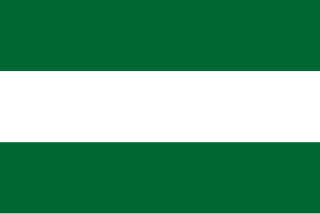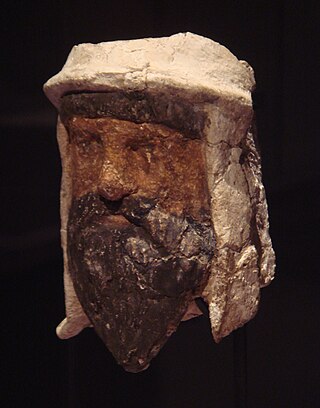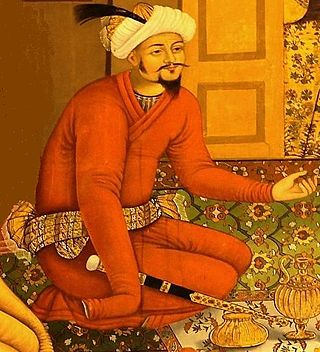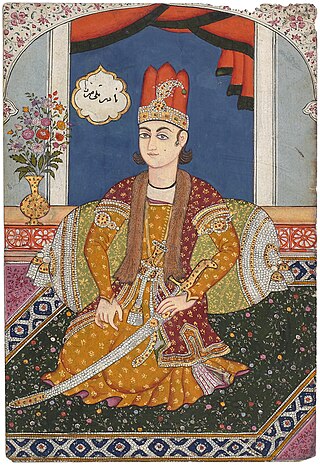Related Research Articles

The Durrani Empire or the Afghan Empire, also known as the Sadozai Kingdom, was an Afghan empire that was founded by Durrani tribe of Pashtuns, under the Ahmad Shah Durrani in 1747, that spanned parts of Central Asia, the Iranian plateau, and the Indian subcontinent. At its peak, it ruled over the present-day Afghanistan, much of Pakistan, parts of northeastern and southeastern Iran, eastern Turkmenistan, and northwestern India. Next to the Ottoman Empire, the Durrani Empire is considered to be among the most significant Islamic empires of the second half of the 18th century.

Tajikistan harkens to the Samanid Empire (819–999). The Tajik people came under Russian rule in the 1860s. The Basmachi revolt broke out in the wake of the Russian Revolution of 1917 and was quelled in the early 1920s during the Russian Civil War. In 1924, Tajikistan became an Autonomous Soviet Socialist Republic of the Soviet Union, the Tajik ASSR, within Uzbekistan. In 1929, Tajikistan was made one of the component republics of the Soviet Union – Tajik Soviet Socialist Republic – and it kept that status until gaining independence 1991 after the dissolution of the Soviet Union.

The Chagatai Khanate, or Chagatai Ulus was a Mongol and later Turkicized khanate that comprised the lands ruled by Chagatai Khan, second son of Genghis Khan, and his descendants and successors. At its height in the late 13th century the khanate extended from the Amu Darya south of the Aral Sea to the Altai Mountains in the border of modern-day Mongolia and China, roughly corresponding to the area once ruled by the Qara Khitai.

The Uzbek Khanate, also known as the Abulkhair Khanate was a Shaybanid state preceding the Khanate of Bukhara. During the few years it existed, the Uzbek Khanate was the preeminent state in Central Asia, ruling over most of modern-day Uzbekistan, much of Kazakhstan and Turkmenistan, and parts of southern Russia. This is the first state of the Abulkhairids, a branch of the Shaybanids.

The Khanate of Khiva was a Central Asian polity that existed in the historical region of Khwarazm from 1511 to 1920, except for a period of Afsharid occupation by Nader Shah between 1740 and 1746. Centred in the irrigated plains of the lower Amu Darya, south of the Aral Sea, with the capital in the city of Khiva. It covered present-day western Uzbekistan, southwestern Kazakhstan and much of Turkmenistan before the Russian conquest at the second half of the 19th century.

The Emirate of Bukhara was a Muslim polity in Central Asia that existed from 1785 to 1920 in what is now Uzbekistan, Tajikistan, Turkmenistan and Kazakhstan. It occupied the land between the Amu Darya and Syr Darya rivers, known formerly as Transoxiana. Its core territory was the fertile land along the lower Zarafshon river, and its urban centres were the ancient cities of Samarqand and the emirate's capital, Bukhara. It was contemporaneous with the Khanate of Khiva to the west, in Khwarazm, and the Khanate of Kokand to the east, in Fergana. In 1920, it ceased to exist with the establishment of the Bukharan People's Soviet Republic.

The Khanate of Bukhara was an Uzbek state in Central Asia from 1501 to 1785, founded by the Abu'l-Khayrid dynasty, a branch of the Shaybanids. From 1533 to 1540, Bukhara briefly became its capital during the reign of Ubaydallah Khan. The Khanate reached its greatest extent and influence under its penultimate Abu'l-Khayrid ruler, the scholarly Abdullah Khan II.

Valī Muḥammad Khān the son of jani bek was a leader of the Ashtarkhanid dynasty in the Khanate of Bukhara from 1605–1611 AD.

Ali-qoli Khan, commonly known by his regnal title Adel Shah was the second shah of Afsharid Iran, ruling from 1747 to 1748. He was the nephew and successor of Nader Shah, the founder of the Afsharid dynasty.

The Manghud, or Manghit were a Mongol tribe of the Urud-Manghud federation. Manghuds who moved to the Desht-i Qipchaq steppe were Turkified. They established the Nogai Horde in the 14th century and the Manghit dynasty to rule the Emirate of Bukhara in 1785. They took the Islamic title of Emir instead of the title of Khan, since they were not descendants of Genghis Khan and rather based their legitimacy as rulers on Islam. The clan name was used for Mongol vanguards as well. Members of the clan live in several regions of Central Asia and Mongolia.

Nader Shah Afshar was the founder of the Afsharid dynasty of Iran and one of the most powerful rulers in Iranian history, ruling as shah of Iran (Persia) from 1736 to 1747, when he was assassinated during a rebellion. He fought numerous campaigns throughout the Middle East, the Caucasus, Central Asia, and South Asia, such as the battles of Herat, Mihmandust, Murche-Khort, Kirkuk, Yeghevārd, Khyber Pass, Karnal, and Kars. Because of his military genius, some historians have described him as the Napoleon of Persia, the Sword of Persia, or the Second Alexander. Nader belonged to the Turkoman Afshars, one of the seven Qizilbash tribes that helped the Safavid dynasty establish their power in Iran.

Timur Shah Durrani, also known as Timur Shah Abdali or Taimur Shah Abdali was the second ruler of the Afghan Durrani Empire, from November 1772 until his death in 1793. An ethnic Pashtun, he was the second eldest son of Ahmad Shah Durrani.

During the mid-eighteenth century the Afsharid empire of Nader Shah embarked upon the conquest and annexation of the Khanates of Bukhara and Khiva. The initial engagements were fought in the late 1730s by Nader Shah's son and viceroy Reza Qoli Mirza who gained a few notable victories in this theatre while Nader was still invading India to the south. Reza Qoli's invasions of Khiva angered Ilbars Khan, the leader of Khiva. When Ilbars threatened to make a counter-attack Nader ordered hostilities to cease despite his son's successes and later returned victoriously from Delhi to embark on a decisive campaign himself.

Reza Qoli Mirza Afshar was the eldest son of Nader Shah, King of Afsharid Iran. After his father's coronation in 1736, Reza Qoli, aged 17, became the Governor of the province of Khorasan. During his tenure, he subdued rebellious khans and marched up to Bukhara to put an end to the Khanate of Bukhara, his father's enemies. Before heading off to India, Nader Shah appointed Reza Qoli the regent of Iran. Reza Qoli ensured peace through harsh measures when collecting taxes and executed people for petty crimes. He had Tahmasp II and Abbas III, two pretenders to the throne, killed, which caused an uproar among the people. When Nader Shah returned from India, he dismissed Reza Qoli as regent, snubbing him for his actions during the regency.

After Nader Shah was assassinated in 1747, his nephew Ali Qoli seized the throne and proclaimed himself Adil Shah. He ordered the execution of all Nader's sons and grandsons, with the exception of the 13-year-old Shahrokh, the son of Reza Qoli.
Pūl was a historical Russian currency that circulated in Russian Turkestan. Pūls were used in Golden Horde, Afghanistan, Bukhara, Chagatai Khanate, Kokand Khanate, Dzungar Khanate, and other Eurasian principalities, it was a copper coin of very small denomination, 1/60 of an altyn.

Afsharid Iran, also referred as the Afsharid Empire, was an Iranian empire established by the Turkoman Afshar tribe in Iran's north-eastern province of Khorasan, establishing the Afsharid dynasty that would rule over Iran during the mid-eighteenth century. The dynasty's founder, Nader Shah, was a successful military commander who deposed the last member of the Safavid dynasty in 1736, and proclaimed himself Shah.
The Qajar Principality of Merv was an independent principality that existed in Central Asia from c.1747 to 1788. It was ruled by the 'Izz al-Dinlu clan of the Qajars of Merv, who had been governors of the oasis since Safavid times. It gained its independence after the death of Nader Shah in 1747 and had good relations with the ruler of Bukhara, Daniyal Biy. When his son, Shah Murad took over in 1785, he launched a campaign that killed the ruler of the principality, Bayram 'Ali Khan Qajar. By 1788 the entire oasis was conquered and annexed to Bukhara. The last ruler, Mohammad Husayn Khan, fled to Iran.

Nadir Shah Afshar's capture of Samarkand, one of the political and economic centers of the region, during his Central Asian campaign. According to Nader Shah, who was an admirer of Amir Timur, Samarkand had a symbolic meaning. The capture occurred in 1740 and Nader Shah entered Samarkand almost unopposed. According to legend, Nader Shah brought the double doors of the Bibi-Khanym Mosque made of gold, silver, precious stones, jewelry and other precious metals, located in Samarkand, as well as a number of architects, artists, and scientists, to the center of the Afshar Empire.
The Janids or Astrakhanids were a Muslim ruling dynasty in Central Asia. They ruled the Khanate of Bukhara from 1599 unti 1785.
References
- Geiss, Paul Georg (2004), The Problem of Political Order in the Khanate of Khokand: Between tribalism and patrimonialism, LIT Verlag Münster, pp. 53–65
- Panoevna, Toshova Sharifa (2020-07-31). "Official And Unofficial Versions Of Bukhara's History: Comparative Analysis Of The Works Of "Tuhfa-Yi Shahi" And "Tarikh-I Salatin-I Manghitiya"". The American Journal of Interdisciplinary Innovations and Research. 2 (7): 60–69. doi: 10.37547/tajiir/Volume02Issue07-11 .[ permanent dead link ]
- Pickett, James (2016), "Nadir Shah's Peculiar Central Asian Legacy: Empire, Conversion Narratives, and the Rise of New Scholarly Dynasties", International Journal of Middle East Studies
- Soucek, Svat (2000), A History of Inner Asia, Oxford: Oxford University Press
- Levi, Scott C. (2017), The Rise and Fall of Khoqand, 1709-1876, Pittsburgh: University of Pittsburgh Press